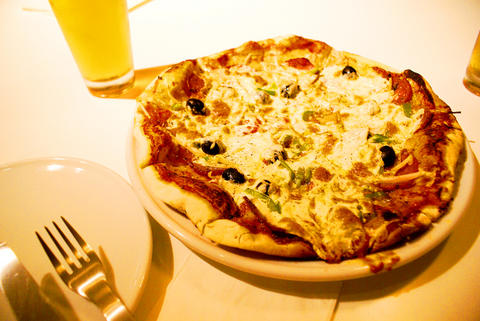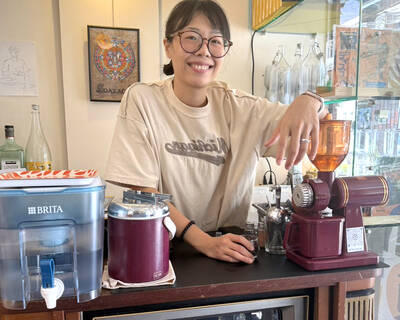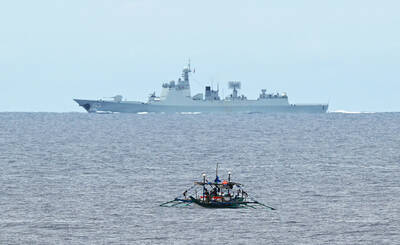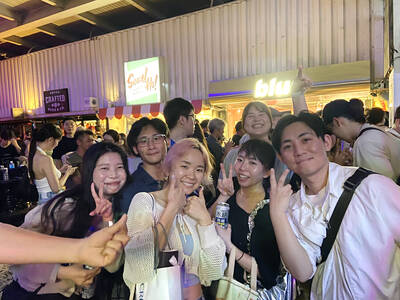Woolloomooloo means "bountiful harvest," or, as Jimmy Yang (楊啟鉉), the laid back proprietor and chef of the cafe bearing the Aboriginal name, says, "Dude, there is a lot of fish here." It's also the name of a recently gentrified area of Sydney, Australia, that features European-style cafes and is the inspiration for the architect's labor of love.
"All architects dream of opening a cafe," said Yang, who lived in Melbourne for 20 years.
Opened six months ago, the cafe is situated on a quiet street close to Taipei Songshan Airport, and a 10-minute walk from the Zhongshan Junior High School (中山國中) MRT station.

PHOTO: NOAH BUCHAN, TAIPEI TIMES
Woolloomooloo has a modern, chic decor. The exposed cement floors and whitewashed walls and wooden tables and shelves are complimented by soft track lighting. Two-thirds of the eating area is given over to two large tables - one square, the other rectangular. Yang has spaced the chairs far enough apart that different parties can dine at the same table without fear of disturbance. On weekends, however, the two tables are often packed with larger parties sipping wine and eating cheese and salami (NT$150 for two up to NT$450 for six).
The other third consists of five two-seater tables and is separated by a standup bar with stools. Large picture windows provide soft natural lighting during the day and glimpses of the tree-lined street.
Apart from the atmosphere, regulars come to sample the limited but mouth-watering menu of drinks and food. There is an emphasis on coffee (NT$100 to NT$150) - the beans are flown in weekly by Tobys Estate, an Australian coffee company - as Yang thinks it's difficult to find a good cup of coffee in Taipei.
"Too often restaurants serve coffee that isn't fresh because it's shipped rather than flown to Taiwan," he said.
Yang stocks a wide range of Australian bottled beers including the popular Crown (NT$200) and a selection of ales by Coopers (NT$150). The wine list is Australian and ranges from NT$1,300 to NT$3,400 per bottle. Glasses of house wine are a bit pricey at NT$230 for the white and NT$250 for the red.
Where he can, Yang makes all his dishes from scratch. The dough used in the pizza is made the day before and is rolled and topped at the time of ordering. His pasta dishes (NT$180 to NT$260) are all made using fresh pasta ordered from a local company, who makes all their pasta using organic semolina flour imported from Australia.
As for the food, the pizza with salami (NT$450) is one of the best in town. It came loaded with mozzarella, fresh slivers of green peppers and onions, whole olives (with the pits) and generous portions of salami. The sauce was rich with tomatoes and spices and the thin crust was cooked so that it was crispy outside.

Cheng Ching-hsiang (鄭青祥) turned a small triangle of concrete jammed between two old shops into a cool little bar called 9dimension. In front of the shop, a steampunk-like structure was welded by himself to serve as a booth where he prepares cocktails. “Yancheng used to be just old people,” he says, “but now young people are coming and creating the New Yancheng.” Around the corner, Yu Hsiu-jao (饒毓琇), opened Tiny Cafe. True to its name, it is the size of a cupboard and serves cold-brewed coffee. “Small shops are so special and have personality,” she says, “people come to Yancheng to find such treasures.” She

Late last month Philippines Foreign Affairs Secretary Theresa Lazaro told the Philippine Senate that the nation has sufficient funds to evacuate the nearly 170,000 Filipino residents in Taiwan, 84 percent of whom are migrant workers, in the event of war. Agencies have been exploring evacuation scenarios since early this year, she said. She also observed that since the Philippines has only limited ships, the government is consulting security agencies for alternatives. Filipinos are a distant third in overall migrant worker population. Indonesia has over 248,000 workers, followed by roughly 240,000 Vietnamese. It should be noted that there are another 170,000

Hannah Liao (廖宸萱) recalls the harassment she experienced on dating apps, an experience that left her frightened and disgusted. “I’ve tried some voice-based dating apps,” the 30-year-old says. “Right away, some guys would say things like, ‘Wanna talk dirty?’ or ‘Wanna suck my d**k?’” she says. Liao’s story is not unique. Ministry of Health and Welfare statistics show a more than 50 percent rise in sexual assault cases related to online encounters over the past five years. In 2023 alone, women comprised 7,698 of the 9,413 reported victims. Faced with a dating landscape that can feel more predatory than promising, many in

“This is one of those rare bits of TikTok fitness advice with a lot of truth behind it,” says Bethan Crouse, performance nutritionist at Loughborough University. “Sometimes it’s taken a bit too literally, though! You see people chugging protein drinks as they’re scanning out of their gym.” Crouse recommends the athletes she works with consume 20-30g of protein within 30-60 minutes of finishing a resistance training session. “The act of exercising our muscles increases the breakdown of muscle proteins,” she says. “In order to restore, or hopefully improve them — and get gains such as increased muscle mass or strength —